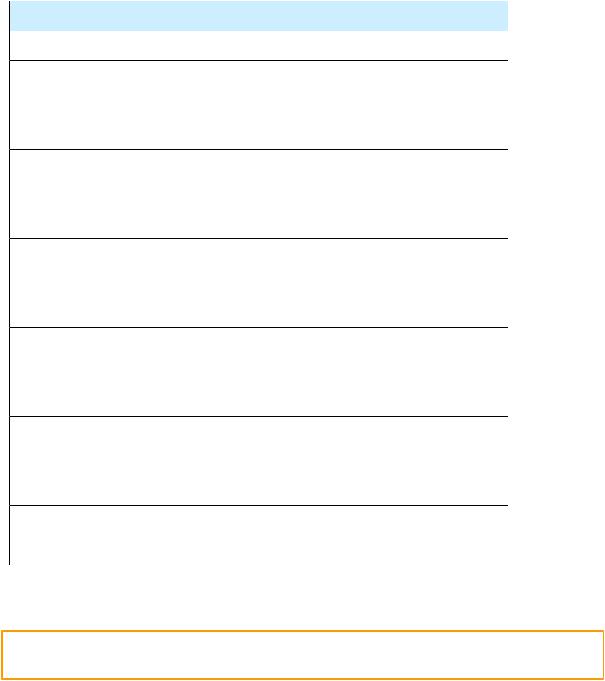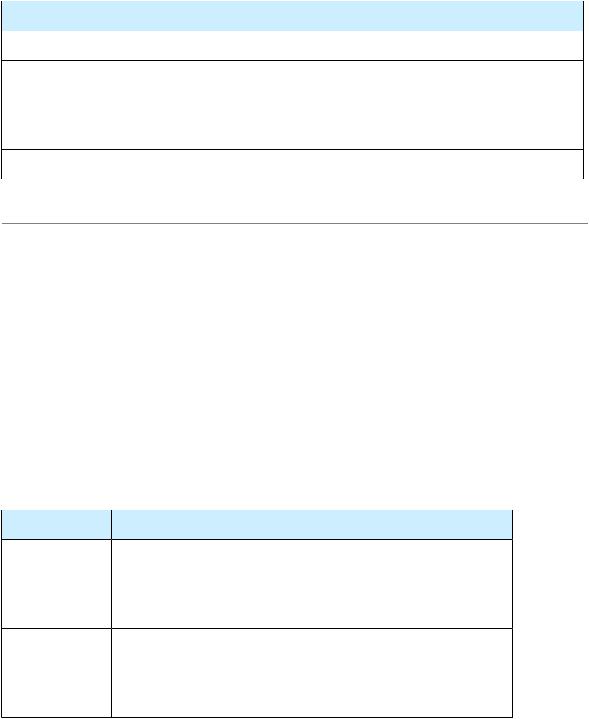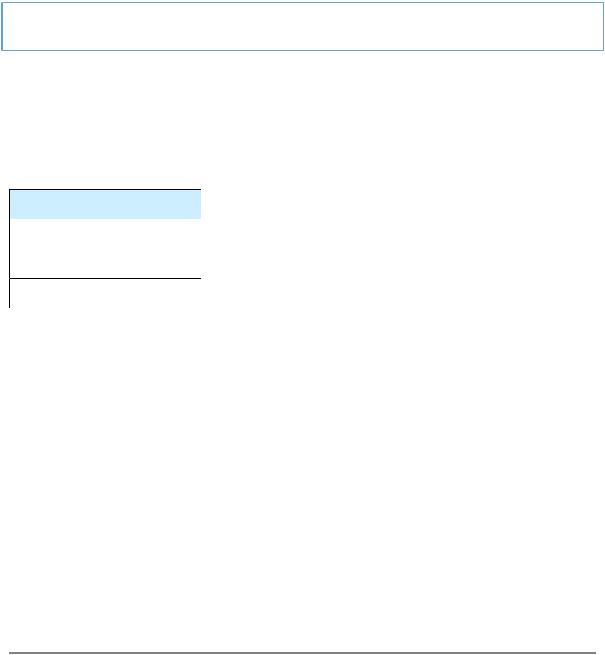
- •Contents
- •Figures and Tables
- •The Design Process
- •Involving Users in the Design Process
- •Know Your Audience
- •Analyze User Tasks
- •Build Prototypes
- •Observe Users
- •Guidelines for Conducting User Observations
- •Making Design Decisions
- •Avoid Feature Cascade
- •Apply the 80 Percent Solution
- •Characteristics of Great Software
- •High Performance
- •Ease of Use
- •Attractive Appearance
- •Reliability
- •Adaptability
- •Interoperability
- •Mobility
- •Human Interface Design
- •Human Interface Design Principles
- •Metaphors
- •Reflect the User’s Mental Model
- •Explicit and Implied Actions
- •Direct Manipulation
- •User Control
- •Feedback and Communication
- •Consistency
- •WYSIWYG (What You See Is What You Get)
- •Forgiveness
- •Perceived Stability
- •Aesthetic Integrity
- •Modelessness
- •Managing Complexity in Your Software
- •Keep Your Users in Mind
- •Worldwide Compatibility
- •Cultural Values
- •Language Differences
- •Text Display and Text Editing
- •Resources
- •Universal Accessibility
- •Visual Disabilities
- •Hearing Disabilities
- •Physical Disabilities
- •Extending the Interface
- •Build on the Existing Interface
- •Don’t Assign New Behaviors to Existing Objects
- •Create a New Interface Element Cautiously
- •Prioritizing Design Decisions
- •Meet Minimum Requirements
- •Deliver the Features Users Expect
- •Differentiate Your Application
- •The Mac OS X Environment
- •The Always-On Environment
- •Displays
- •The Dock
- •Conveying Information in the Dock
- •Clicking in the Dock
- •The Finder
- •File Formats and Filename Extensions
- •Internationalization
- •Multiple User Issues
- •Resource Management
- •Threads
- •Using Mac OS X Technologies
- •Address Book
- •Animation
- •Automator
- •Bonjour
- •Colors
- •Dashboard
- •High-Level Design Guidelines for Widgets
- •User-Interface Design Guidelines for Widgets
- •Fonts
- •Preferences
- •Printing
- •Security
- •Speech
- •Spotlight
- •User Assistance
- •Apple Help
- •Help Tags
- •Software Installation and Software Updates
- •Packaging
- •Identify System Requirements
- •Bundle Your Software
- •Installation
- •Use Internet-Enabled Disk Images
- •Drag-and-Drop Installation
- •Installation Packages
- •General Installer Guidelines
- •Setup Assistants
- •Updating Installed Applications
- •User Input
- •The Mouse and Other Pointing Devices
- •Clicking
- •Double-Clicking
- •Pressing and Holding
- •Dragging
- •The Keyboard
- •The Functions of Specific Keys
- •Character Keys
- •Modifier Keys
- •Arrow Keys
- •Function Keys
- •Keyboard Shortcuts
- •Reserved Keyboard Shortcuts
- •Creating Your Own Keyboard Shortcuts
- •User-Defined Keyboard Shortcuts
- •Keyboard Focus and Navigation
- •Type-Ahead and Key-Repeat
- •Selecting
- •Selection Methods
- •Selection by Clicking
- •Selection by Dragging
- •Changing a Selection
- •Selections in Text
- •Selecting With the Mouse
- •What Constitutes a Word
- •Selecting Text With the Arrow Keys
- •Selections in Spreadsheets
- •Selections in Graphics
- •Editing Text
- •Inserting Text
- •Deleting Text
- •Replacing a Selection
- •Intelligent Cut and Paste
- •Editing Text Fields
- •Entering Passwords
- •Drag and Drop
- •Drag-and-Drop Overview
- •Drag-and-Drop Semantics
- •Move Versus Copy
- •When to Check the Option Key State
- •Selection Feedback
- •Single-Gesture Selection and Dragging
- •Background Selections
- •Drag Feedback
- •Destination Feedback
- •Windows
- •Text
- •Lists
- •Multiple Dragged Items
- •Automatic Scrolling
- •Using the Trash as a Destination
- •Drop Feedback
- •Finder Icons
- •Graphics
- •Text
- •Transferring a Selection
- •Feedback for an Invalid Drop
- •Clippings
- •Text
- •Fonts
- •Style
- •Inserting Spaces Between Sentences
- •Using the Ellipsis Character
- •Using the Colon Character
- •Labels for Interface Elements
- •Capitalization of Interface Element Labels and Text
- •Using Contractions in the Interface
- •Using Abbreviations and Acronyms in the Interface
- •Developer Terms and User Terms
- •Icons
- •Icon Genres and Families
- •Application Icons
- •User Application Icons
- •Viewer, Player, and Accessory Icons
- •Utility Icons
- •Document Icons
- •Toolbar Icons
- •Icons for Plug-ins, Hardware, and Removable Media
- •Icon Perspectives and Materials
- •Creating Icons
- •Tips for Designing Icons
- •A Suggested Process for Creating Icons
- •Creating Icons for Mac OS X v10.5 and Later
- •Scaling Your Artwork
- •Designing Toolbar Icons
- •Designing Icons for Icon Buttons
- •Designing Icons for Capsule-Style Toolbar Controls
- •Designing Icons for Rectangular-Style Toolbar Controls
- •System-Provided Images
- •System-Provided Images for Use in Controls
- •System-Provided Images for Use as Standalone Buttons
- •System-Provided Images for Use as Toolbar Items
- •System-Provided Images that Indicate Privileges
- •A System-Provided Drag Image
- •Cursors
- •Standard Cursors
- •Designing Your Own Cursors
- •Menus
- •Menu Behavior
- •Designing the Elements of Menus
- •Titling Menus
- •Naming Menu Items
- •Using Icons in Menus
- •Using Symbols in Menus
- •Toggled Menu Items
- •Grouping Items in Menus
- •Hierarchical Menus (Submenus)
- •The Menu Bar and Its Menus
- •The Apple Menu
- •The Application Menu
- •The Application Menu Title
- •The Application Menu Contents
- •The File Menu
- •The Edit Menu
- •The Format Menu
- •The View Menu
- •Application-Specific Menus
- •The Window Menu
- •The Help Menu
- •Menu Bar Extras
- •Contextual Menus
- •Dock Menus
- •Windows
- •Types of Windows
- •Window Appearance
- •Window Elements
- •The Title Bar
- •The Window Title
- •Title Bar Buttons
- •Indicating Changes with the Close Button
- •The Proxy Icon
- •Toolbars
- •Toolbar Appearance and Behavior
- •Designing a Toolbar
- •Scope Bars
- •Scope Bar Appearance and Behavior
- •Designing a Scope Bar
- •Source Lists
- •Source List Behavior and Appearance
- •Designing a Source List
- •Bottom Bars
- •Bottom Bar Appearance and Behavior
- •Designing a Bottom Bar
- •Drawers
- •When to Use Drawers
- •Drawer Behavior
- •Window Behavior
- •Opening Windows
- •Naming New Windows
- •Positioning Windows
- •Moving Windows
- •Resizing and Zooming Windows
- •Minimizing and Expanding Windows
- •Closing Windows
- •Window Layering
- •Main, Key, and Inactive Windows
- •Click-Through
- •Scrolling Windows
- •Automatic Scrolling
- •Panels
- •Inspector Windows
- •Transparent Panels
- •When to Use Transparent Panels
- •Designing a Transparent Panel
- •Fonts Window and Colors Window
- •About Windows
- •Dialogs
- •Types of Dialogs and When to Use Them
- •Sheets (Document-Modal Dialogs)
- •Alerts
- •Dialog Appearance and Behavior
- •Accepting Changes
- •Dismissing Dialogs
- •Providing an Apply Button in a Dialog
- •Expanding Dialogs
- •Find Windows
- •Preferences Windows
- •The Open Dialog
- •Dialogs for Saving, Closing, and Quitting
- •Save Dialogs
- •Closing a Document With Unsaved Changes
- •Attempting to Save a Locked or Read-Only Document
- •Saving Documents During a Quit Operation
- •The Choose Dialog
- •The Print Dialog
- •Print Dialog
- •Page Setup Dialog
- •Controls
- •Window-Frame Controls
- •Rectangular-Style Toolbar Controls
- •Rectangular-Style Toolbar Control Usage
- •Rectangular-Style Toolbar Control Contents and Labeling
- •Rectangular-Style Toolbar Control Specifications
- •Rectangular-Style Toolbar Control Implementation
- •Capsule-Style Toolbar Controls
- •Capsule-Style Toolbar Control Usage
- •Capsule-Style Toolbar Control Contents and Labeling
- •Capsule-Style Toolbar Control Specifications
- •Capsule-Style Toolbar Control Implementation
- •Legacy Toolbar Controls
- •Buttons
- •Push Buttons
- •Push Button Usage
- •Push Button Contents and Labeling
- •Push Button Specifications
- •Push Button Implementation
- •Icon Buttons
- •Icon Button Usage
- •Icon Button Contents and Labeling
- •Icon Button Specifications
- •Icon Button Implementation
- •Scope Buttons
- •Scope Button Usage
- •Scope Button Contents and Labeling
- •Scope Button Specifications
- •Scope Button Implementation
- •Gradient Buttons
- •Gradient Button Usage
- •Gradient Button Contents and Labeling
- •Gradient Button Specifications
- •Gradient Button Implementation
- •The Help Button
- •Bevel Buttons
- •Bevel Button Usage
- •Bevel Button Contents and Labeling
- •Bevel Button Specifications
- •Bevel Button Implementation
- •Round Buttons
- •Round Button Usage
- •Round Button Contents and Labeling
- •Round Button Specifications
- •Round Button Implementation
- •Selection Controls
- •Radio Buttons
- •Radio Button Usage
- •Radio Button Contents and Labeling
- •Radio Button Specifications
- •Radio Button Implementation
- •Checkboxes
- •Checkbox Usage
- •Checkbox Contents and Labeling
- •Checkbox Specifications
- •Checkbox Implementation
- •Segmented Controls
- •Segmented Control Usage
- •Segmented Control Contents and Labeling
- •Segmented Control Specifications
- •Segmented Control Implementation
- •Icon Buttons and Bevel Buttons with Pop-Up Menus
- •Pop-Up Menus
- •Pop-Up Menu Usage
- •Pop-Up Menu Contents and Labeling
- •Pop-Up Menu Specifications
- •Pop-Up Menu Implementation
- •Action Menus
- •Action Menu Usage
- •Action Menu Contents and Labeling
- •Action Menu Specifications
- •Action Menu Implementation
- •Combination Boxes
- •Combo Box Usage
- •Combo Box Contents and Labeling
- •Combo Box Specifications
- •Combo Box Implementation
- •Path Controls
- •Path Control Usage
- •Path Control Contents and Labeling
- •Path Control Specifications
- •Path Control Implementation
- •Color Wells
- •Image Wells
- •Date Pickers
- •Date Picker Usage
- •Date Picker Implementation
- •Command Pop-Down Menus
- •Command Pop-Down Menu Usage
- •Command Pop-Down Menu Contents and Labeling
- •Command Pop-Down Menu Specifications
- •Command Pop-Down Implementation
- •Sliders
- •Slider Usage
- •Slider Contents and Labeling
- •Slider Control Specifications
- •Slider Control Implementation
- •The Stepper Control (Little Arrows)
- •Stepper Control Specifications
- •Placards
- •Indicators
- •Progress Indicators
- •Determinate Progress Bars
- •Indeterminate Progress Bars
- •Asynchronous Progress Indicators
- •Level Indicators
- •Capacity Indicators
- •Rating Indicators
- •Relevance Indicators
- •Text Controls
- •Static Text Fields
- •Text Input Fields
- •Text Input Field Usage
- •Text Input Field Contents and Labeling
- •Text Input Field Specifications
- •Text Input Field Implementation
- •Token Fields
- •Token Field Usage
- •Token Field Specifications
- •Token Field Implementation
- •Search Fields
- •Search Field Usage
- •Search Field Contents and Labeling
- •Search Field Specifications
- •Search Field Implementation
- •Scrolling Lists
- •Scrolling List Usage
- •Scrolling List Contents and Labeling
- •Scrolling List Specifications
- •Scrolling List Implementation
- •View Controls
- •Disclosure Triangles
- •Disclosure Triangle Usage
- •Disclosure Triangle Contents and Labeling
- •Disclosure Triangle Specifications
- •Disclosure Triangle Implementation
- •Disclosure Buttons
- •Disclosure Button Usage
- •Disclosure Button Contents and Labeling
- •Disclosure Button Specifications
- •Disclosure Button Implementation
- •List Views
- •List View Usage
- •List View Contents and Labeling
- •List View Implementation
- •Column Views
- •Column View Usage
- •Column View Contents and Labeling
- •Column View Implementation
- •Split Views
- •Split View Usage
- •Split View Specifications
- •Split View Implementation
- •Tab Views
- •Tab View Usage
- •Tab View Contents and Labeling
- •Tab View Specifications
- •Tab View Implementation
- •Grouping Controls
- •Separators
- •Separator Usage
- •Separator Labeling
- •Separator Specifications
- •Separator Implementation
- •Group Boxes
- •Group Box Usage
- •Group Box Contents and Labeling
- •Group Box Specifications
- •Group Box Implementation
- •Layout Guidelines
- •Positioning Regular-Size Controls in a Window Body
- •A Simple Preferences Window
- •A Tabbed Window
- •A Standard Alert
- •Positioning Small and Mini Controls in a Window Body
- •Layout Example for Small Controls
- •Layout Example for Mini Controls
- •Grouping Controls in a Window Body
- •Grouping with White Space
- •Grouping with Separators
- •Grouping with Group Boxes
- •Positioning Text and Controls in a Bottom Bar
- •Glossary
- •Index

C H A P T E R 8
User Input
Home, End
Pressing the Home key is equivalent to moving the scrollers all the way to the top and to the left. In a text document, for example, pressing Home scrolls to the beginning of the document; in a spreadsheet, it may scroll to the beginning of the spreadsheet or to the beginning of a row. These keys should also work in scrolling lists to display the top or bottom of the list.
End is the opposite of Home: It scrolls to the end of a document.
If the beginning or end of the document is already reached, pressing Home or End produces a system alert sound. Pressing the Home or End key has no effect on the location of the insertion point or selected data.
Page Up, Page Down
Pressing Page Up or Page Down scrolls the document up or down one page. If an entire page can’t be displayed in the window, these keys first scroll incrementally up or down, until the top or bottom of the page is visible, before scrolling to the next page. These keys should also work in scrolling lists.
If the beginning or end of the document is reached, pressing Page Up or Page Down produces a system alert sound. Pressing the Page Up or Page Down key has no effect on the location of the insertion point or selected data.
Keyboard Shortcuts
Keyboard shortcuts are used throughout Mac OS X to provide quick ways for users to initiate certain actions. Many are provided by the operating system to meet both general usability needs and accessibility needs. The operating system therefore reserves certain keys and keyboard combinations for its use. These combinations, listed in Table 8-3 and Table 8-4 affect all applications and should not be used for any other function. Other keyboard shortcuts are used by the Universal Access features in Mac OS X and should be avoided.
In addition to the keyboard shortcuts reserved by the system, there are a large number of keyboard shortcuts that have a well established meaning, such as Command-S for Save and Command-Q for Quit. Users accustomed to running applications in Mac OS X expect these keyboard shortcuts to be available and to mean the same thing in each application they use. An application that overrides these shortcuts, such as one that uses Command-Q for a Query command instead of Quit, runs the risk of unnecessarily confusing and frustrating its users.
These common keyboard shortcuts are not reserved by the system, but they are highly recommended for applications that offer the associated commands. If your application does not offer all of these common commands, be sure you don't override these keyboard shortcuts and associate them with other commands your application does implement. A complete list of both system-reserved and commonly used keyboard shortcuts in Mac OS X is provided in “Keyboard Shortcuts Quick Reference” (page 355)
You may also define keyboard shortcuts in your application for frequently used commands. Some guidelines on how to create appropriate shortcuts are in “Creating Your Own Keyboard Shortcuts” (page 105) Other sections of this document list recommended keyboard shortcuts, where appropriate, to help you provide a consistent and familiar user experience in your application.
Reserved Keyboard Shortcuts
Don’t use the keys and key combinations in Table 8-3 for actions other than those listed in the table.
The Keyboard |
103 |
2008-06-09 | © 1992, 2001-2003, 2008 Apple Inc. All Rights Reserved.

C H A P T E R 8
User Input
Table 8-3 Keyboard shortcuts reserved by the operating system
Keys |
Action |
Esc
Command-Tab
Command-Shift-Tab
Command-Option-D Command-H Command-Option-H Command-Shift-Q Command-Shift-Option-Q Command-Shift-Option-Control-Q Command–Space bar Command-Option-Esc Command-F5
Control-F1
Control-F7
F9
F10
F11
F12
Cancel the current action
Activate the most recently used open application Activate the least recently used open application Show or hide the Dock
Hide the active application
Hide other applications (all but the active one) Log out
Log out without confirmation
Force log out without confirmation
Show or hide Spotlight search field
Open the Force Quit dialog
Turn VoiceOver on or off
Turn full keyboard navigation on or off
Toggle keyboard navigation in windows and dialogs Tile or untile all open windows
Tile or untile all open windows in current application Hide or show all open windows
Display or hide Dashboard
Mac OS X also provides full keyboard access mode, in which users can navigate through windows and dialogs. Whenthismodeisactive,otherkeyboardcombinationsmaybereservedbydefault. (See AccessibilityOverview.)
Important: Your application should not override the implementation of keyboard focus and navigation in Mac OS X. These features provide functionality for users with special needs.
Table 8-4 shows several key combinations that are reserved for use with localized versions of system software, localized keyboards, keyboard layouts, and input methods. These key combinations don’t correspond directly to menu commands.
104 |
The Keyboard |
2008-06-09 | © 1992, 2001-2003, 2008 Apple Inc. All Rights Reserved.

C H A P T E R 8
User Input
Table 8-4 |
Key combinations reserved for international systems |
|
Keys |
|
Action |
Command–Space bar |
Rotate through enabled script systems |
|
Command–Option–Space bar |
Rotate through keyboard layouts and input methods within a script |
|
Command–modifier key–Space bar |
Apple reserved |
|
Command–Right Arrow |
Change keyboard layout to current layout of Roman script |
|
Command–Left Arrow |
Change keyboard layout to current layout of system script |
|
Creating Your Own Keyboard Shortcuts
Apple may reserve other keyboard shortcuts in the future, so be careful about adding your own. Before you consider creating a keyboard shortcut, be sure to look at the keyboard shortcuts listed in “Keyboard Shortcuts Quick Reference” (page 355) so you can avoid overriding the shortcuts users already know.
You might also consider examining the keyboard shortcuts used in other applications that target the same user audience your application targets. If your users are likely to be familiar with these other applications, you should try to avoid overriding the shortcuts they're used to using.
You should provide keyboard shortcuts onlyforfrequentlyusedcommands, not for every command. Presenting the user with too many keyboard shortcuts can be overwhelming and can make an application's user interface seem difficult to learn.
Use the Command key as the main modifier key for keyboard equivalents. For a command that complements another more common command, you can add Shift. The table below shows some recommended keyboard equivalents using Shift and their relation with the command they complement.
Table 8-5 Recommended keyboard shortcuts using Shift to complement other commands
Keys |
Command |
Complemented command |
Command-Shift-A |
Deselect All |
Command-A (Select All) |
Command-Shift-G |
Find Previous |
Command-G (Find Again) |
Command-Shift-P |
Page Setup |
Command-P (Print) |
Command-Shift-S |
Save As |
Command-S (Save) |
Command-Shift-V |
Paste as (Paste as Quotation, for example) |
Command-V (Paste) |
Command-Shift-Z |
Redo |
Command-Z (Undo) |
The Keyboard |
105 |
2008-06-09 | © 1992, 2001-2003, 2008 Apple Inc. All Rights Reserved.

C H A P T E R 8
User Input
Note:Command-Shift-Z would be used for Redo only if Undo and Redo are separate commands (rather than toggled using Command-Z).
If there’s a third, less common command that’s related to a pair of commands that use Command and Command-Shift,youcanuseCommand-Optionforthethirdcommand’skeyboardequivalent. Intheexample in Table 8-6 Save All could be a dynamic menu item (see “Naming Menu Items” (page 163)) that appears in place of Save when the user presses the Option key (rather than a separate menu item). Use combinations like these very rarely.
Table 8-6 Example of using Option to modify a shortcut already using Command
Keys Command
Command-S Save
Command-Shift-S Save As
Command-Option-S Save All
Also use Option for a keyboard shortcut that is a convenience or power-user feature. For example, the Finder uses Command-Option-W for Close All Windows and Command-Option-M for Minimize All Windows.
Because the Control key is already used by some of the universal access features as well as in Cocoa text fields where Emacs-style key bindings are often used, it should be used as a modifier key only when necessary.
Remember that other languages may require modifier keys to generate certain characters. For example, on a French keyboard, Option-5 generates the “{“ character. You can safely use the Command key as a modifier, but avoid using Command and an additional modifier with characters not available on all keyboards. If you must use a modifier key in addition to the Command key, try to use it only with the alphabetic characters (a through z).
When adding custom keyboard shortcuts, try to avoid shortcuts that add a modifier key (such as Option or Shift) to an existing shortcut if the shortcuts have an unrelated function. For example, don’t use Shift-Command-Z as a keyboard shortcut for a command that is unrelated to Undo. Using that shortcut for Redo is appropriate, but using it for something like Calculate or Check Mail is confusing. If you can’t find a unique and easy-to-use keyboard shortcut for a command, don’t use one at all; keep in mind that users may have difficulty pressing multiple modifier keys anyway.
User-Defined Keyboard Shortcuts
Users may modify your application’s keyboard shortcuts and some of the system in Keyboard & Mouse preferences. Even though users can remap keyboard shortcuts, you should adhere to the shortcuts recommendedthroughoutthisdocument. Doingsoprovidesamoreconsistentuserexperience. See “Keyboard Shortcuts Quick Reference” (page 355) for a list of all the reserved and recommended combinations.
106 |
The Keyboard |
2008-06-09 | © 1992, 2001-2003, 2008 Apple Inc. All Rights Reserved.
